The race for the Premier League continued at the John Smith’s stadium where the relegation-threatened home team currently fighting for relegation, Huddersfield Town faced current champions Manchester City. Pep Guardiola had the obligation to win after Liverpool fought more than usual to beat 4-3 Crystal Palace. Manchester City were clear favourites but had to fight more than expected to grab the three points from a team that always felt happy with a tie.
The result left Huddersfield without a manager, as David Wagner left his post by mutual consent leaving the team at the bottom of the table. In this analysis, we dig into the tactical concepts that arose during the game and that allowed Manchester City to score 22 goals in the last four games without conceding.
First half: tight spaces, only one team trying to win
Huddersfield Town started the game with a defensive 4-5-1 that had Diakhaby as the lone attacker. The rest of the team focused on containing the attacks of Manchester City. The five-man midfield line was parked just in the middle between the penalty area and the halfway line.
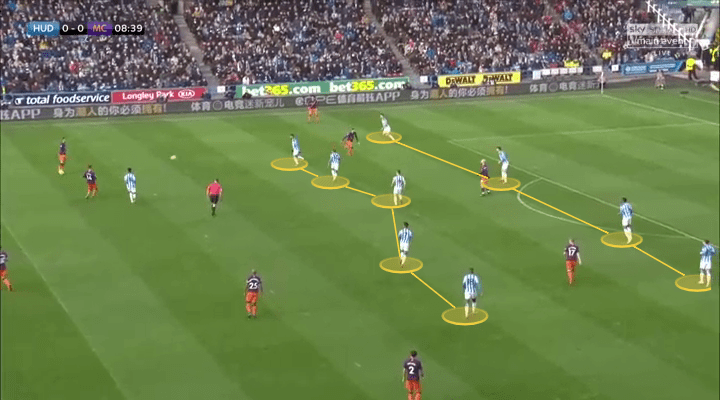
They applied a mix between a defensive zonal-marking and man-marking system. When Manchester City had the ball outside the final third, they stood marking their zone waiting for them to move forward. As City moved closer to their penalty area, they applied individual marking to the player holding the ball and the ones in front of him.
As the visitors rotated the ball laterally, Huddersfield’s man-marking scheme rotated towards the new player holding possession. The system always focused on the midfield and attack of Manchester City. If the ball reached the defensive line, they would not press higher and waited for Guardiola’s men to move forward.
Look at the sequence below where there is no pressure on defenders Laporte and Otamendi. As Danilo and Fernandinho receive the ball, however, Huddersfield immediately press them.
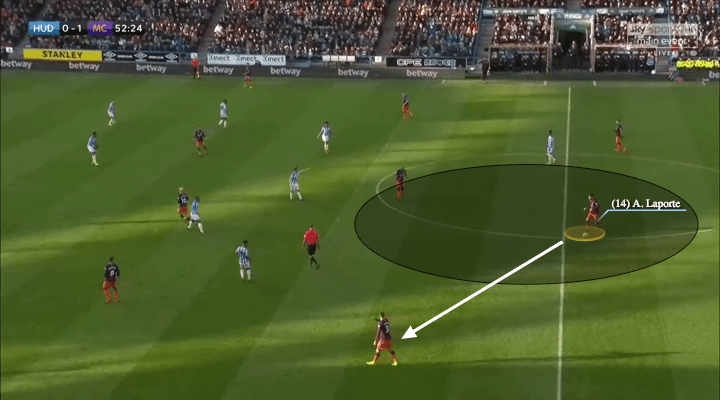
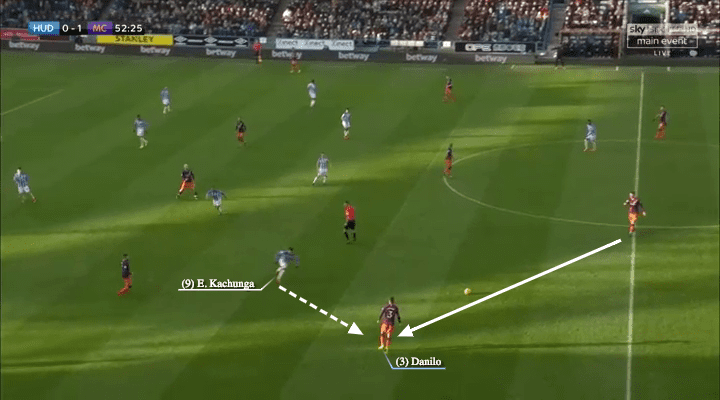
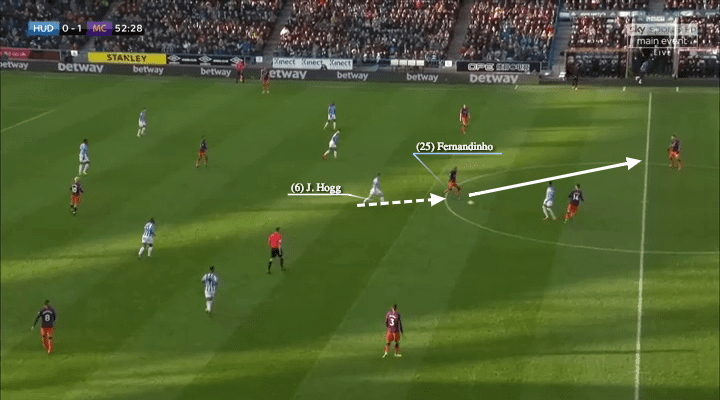
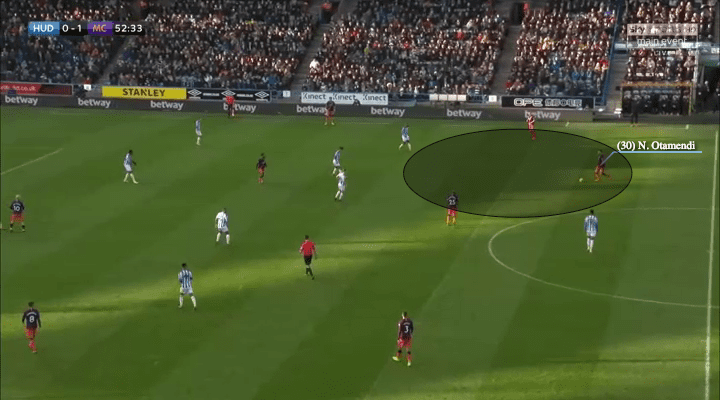
Meanwhile, Manchester City continued with their usual 4-3-3 formation, with some specific rotations, including positioning Danilo as left-back and Walker as right-back. This is something we highlighted in the report against Liverpool where Guardiola picked Laporte at left-back when he had Walker on the bench. Admittedly against Liverpool they had higher defensive concerns with the opposition forwards that could justify that.
Using two natural full-backs allowed Manchester City to better use the wings and rotate the ball to try to open up Huddersfield’s defensive setup. They made more deep, vertical movements to pull some of the midfielders out of their position. In the middle of the pitch, Guardiola had Fernandinho as the central midfielder, with Gündogan and Kevin De Bruyne as inside midfielders.
Manchester City had a hard time trying to open up spaces to get closer to Huddersfield’s goal. The home team’s defensive positioning was very cohesive, all movements were very well mechanised and seemed to have been deeply trained during the week reducing the players’ creativity.
The first goal came after a long shot from Danilo was deflected in. Afterwards, we saw some insinuation of Huddersfield trying to step up and position themselves higher, but it didn’t last and they lacked any attacking strength after. On the other hand Manchester City, although enjoying possession, continued to have trouble creating any clear chances.
On both sides, Manchester City had to use long balls to try and get closer to Huddersfield’s penalty area without much success. On the right wing Sterling had to move back to be able to receive the ball, maybe too much to inflict any danger, and on the left Sane and Gündogan alternated interesting deep runs.
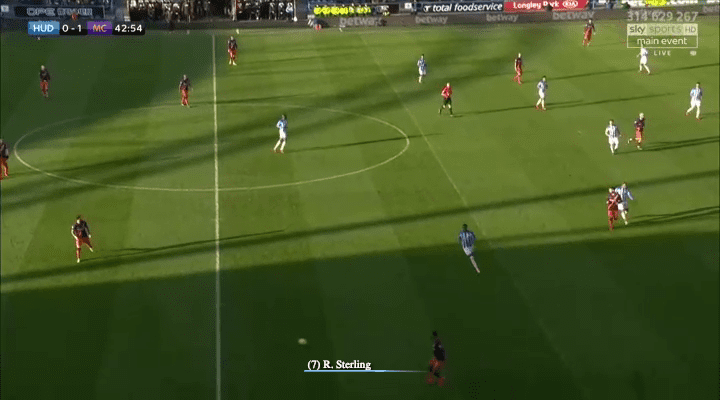
Those runs were more useful in pulling defenders into the middle and allowing the ball to be crossed to the other wide player than getting the ball into the box. Huddersfield players were fast enough to reach the receiving player with two or even three players, though.
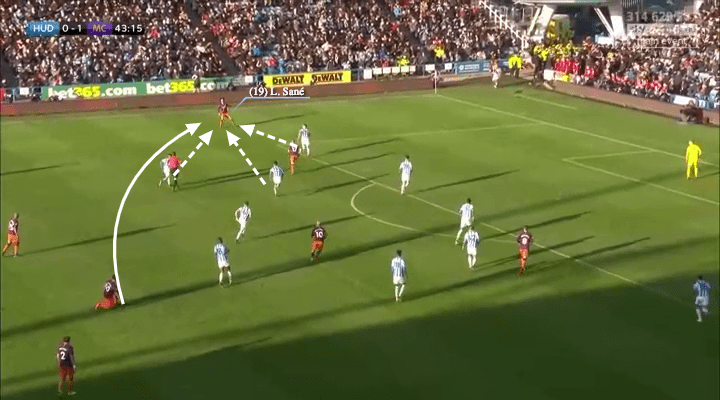
The tight spaces and lack of attacking creativity by Manchester City resulted in very few clear chances for Guardiola’s team. They had seven shots during the first half, but only one on target: the goal by Danilo.
After 10 second-half minutes, the game was over
The second half started in a similar fashion to the first. Huddersfield kept their defensive positioning, while Manchester City kept possession without enough deepness in their build-up. The conservative positioning of the home team resulted in Manchester City losing possession more than usual high up the pitch. Closer to the middle, they were not pressured enough to lose a lot of balls.
In the same direction, Manchester City only recovered six balls in the first third of the pitch out of 77 total recoveries, a small share considering the intense pressure we are used to seeing from Guardiola’s team when they lose the ball. This is because as soon as they recovered possession, Huddersfield tried long balls to Diakhaby that were usually easily recovered by Manchester City.
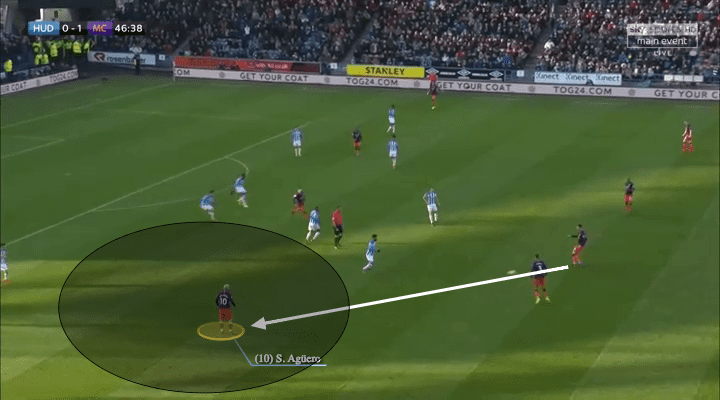
Agüero had a hard time receiving balls with enough advantage close to Huddersfield’s goal. As a result, he was forced to move back or wide to be able to receive the ball. These types of movements are very well managed by the Argentine striker, and usually open up spaces for both wingers and midfielders to receive with much more space in front of them.
The perfect example of these types of movements and positional swaps was the second goal scored by Sterling. As Agüero falls back to receive the ball, he opens a space in the middle that is then used by Sterling to receive a long ball out to the left. Sterling, Sane, Gündogan and Kevin De Bruyne start passing the ball between themselves. Suddenly Sterling, located as a left winger at that moment, moves to the centre of the attacking line, pulling two defenders with him and leaving the left wing open for Sane, who receives unmarked.
He crosses the ball, which is headed home by the same Sterling, now on the right flank of the attack and also completely unmarked. This attacking versatility is probably the biggest asset Guardiola has influenced on Manchester City’s game plan. In the sequence below you can see all the movements happening before the second goal by Sterling.
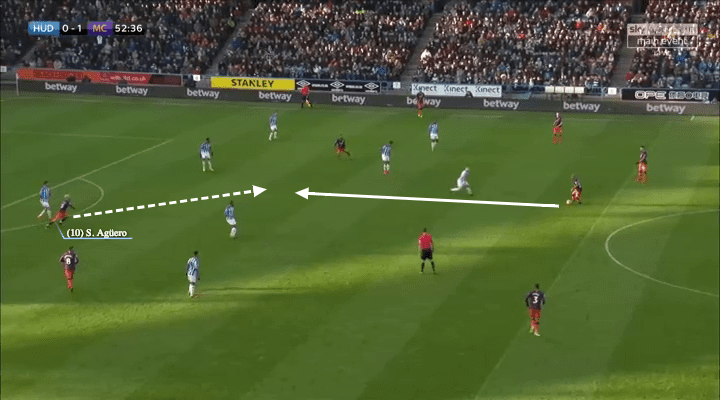
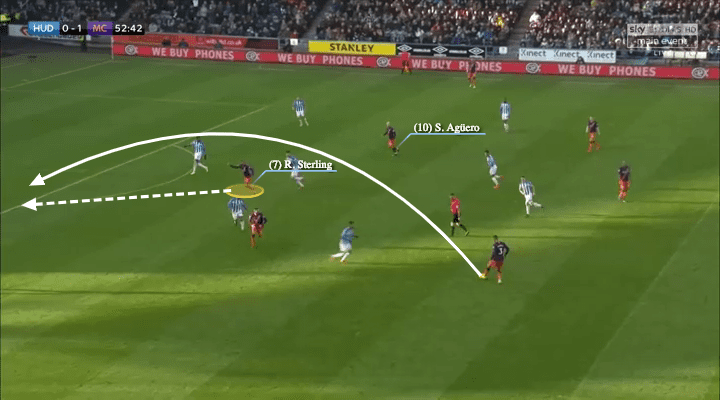
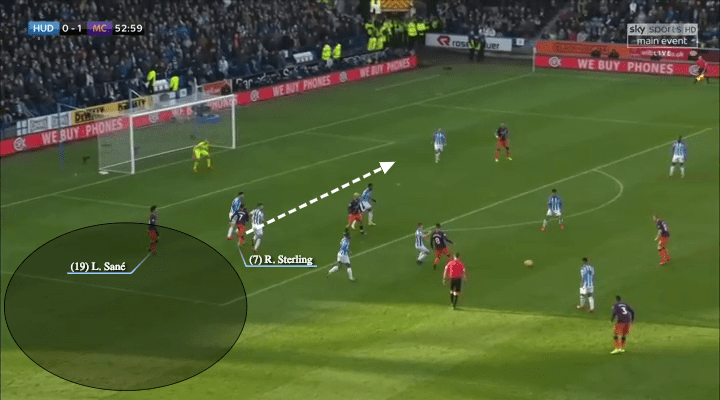
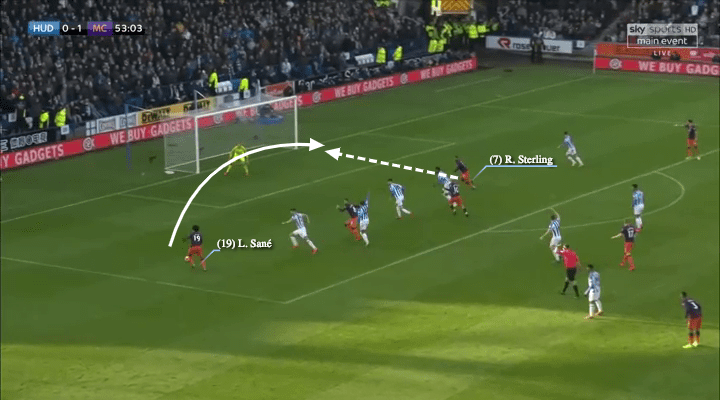
Just two minutes later, a good combination between Agüero and Sane ended up with the German scoring the third and last goal. Afterwards, Guardiola tried several substitutions in his ongoing search for a Fernandinho replacement.
First he tried Gündogan and then Delph as central midfielders, but the results have been unconvincing so far. While Gündogan adds a lot of value in the build-up phase, he lacks the physical strength and persistence of Fernandinho. Delph, meanwhile, is closer to the Brazilian on the defensive side, but doesn’t add differentiation while attacking.
Guardiola also tried Bernardo Silva as a right winger, but the Portuguese player tends to get involved in the build-up phase reducing the attacking strength on that wing. Kevin De Bruyne again completed 90 minutes, but it was not his best game. He was mentally slower, and lacked the precision and leadership he usually shows.
Meanwhile, Huddersfield stepped up in the last 15 minutes and had a couple of good chances to score, mainly at the feet of Mounie and using the left wing. However, he lacked composure to finish the situation correctly. Manchester City’s victory was never under threat.
The fight at the top continues as key games approach
Manchester City are still fighting on all four available fronts: Premier League, Champions League, FA Cup and Carabao Cup. Over the next fortnight or so, they will face key games. In the space of 17 days they will face Arsenal and Chelsea in the Premier League and visit Shalke 04 for the first leg of the round of 16 in the Champions League.
After several games where we have criticised their defensive performance, Manchester City have had four clean sheets in a row. Their attacking production beyond scrutiny. They are they have scored the most goals in Europe’s top leagues. Even still, they need to improve and cement their defensive strength in order to be able to fight for all prizes, especially their biggest dream: the Champions League.
If you love tactical analysis, then you’ll love the digital magazines from totalfootballanalysis.com – a guaranteed 100+ pages of pure tactical analysis covering topics from the Premier League, Serie A, La Liga, Bundesliga and many, many more. Buy your copy of the January issue for just ₤4.99 here, or even better sign up for a ₤50 annual membership (12 monthly issues plus the annual review) right here.

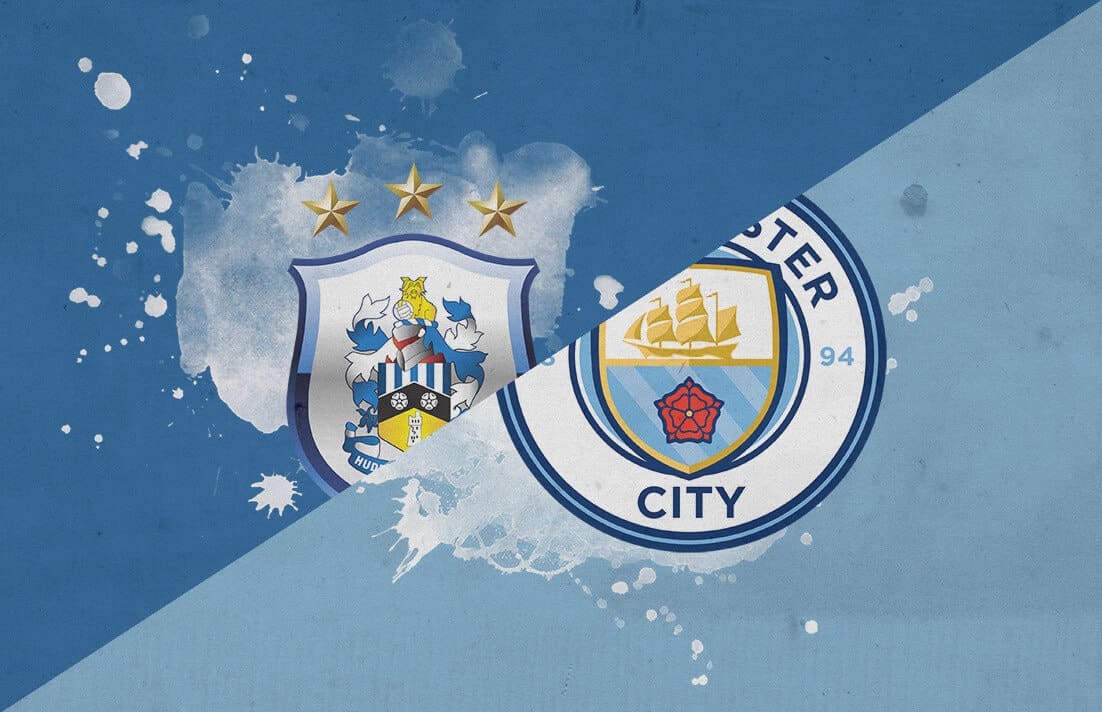


Comments